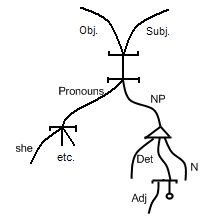Tactic pattern
According to an older view in neurocognitive linguistics (NCL), every stratum has a syntax or tactic pattern, which is also built of lines and nodes. The upward direction within the tactic pattern leads to different syntactic functions.
(This view is still in use by some neurocognitivists while others adhere to an explanation involving the construction.)
Stratificational grammar defined its term "tactics" after Hockett. It has the same Greek root as syntax, referring to arrangements. He said that we could use the term to refer to that part of the structure which is concerned with arrangements at whatever level. So the relationships among elements on one realizational level of the linguistic system are of the same kinds as those on another.
For example, for a noun phrase (NP) in English, a lexotactic pattern will have an upward OR that will relate NPs to the different functions they have, like subject and object.
Lines in the tactic plane connect downward to alternative linguistic units that can have the same function. So at one point we have downward OR connecting, say, to personal pronouns on the one hand or to NP on the other hand.
There are also AND relationships within the structures. A downward AND would be used where there is a combination of syntactic units which together perform a particular function. So for a NP you would connect downwards in an AND relationship to, say, determiner followed by an optional adjective then a noun.
The upward AND would be used in a syntactic structure where a given unit has two functions simultaneously. This would occur for example in the semotactics where a given element, say "John" as in "John kissed Helen," would be both agent of the process of kissing and the topic in the topic-comment construction. So it simultaneously functions as topic and agent -- it will have an upward AND linking it to the two functions. Or, in "Harry kicked himself," there is a third line, as "Harry" is the target of the process.
Other posited tactic patterns have included morphotactics and phonotactics.
Sources
- Language and Reality: Selected Writings of Sydney Lamb, Continuum, 2004.
